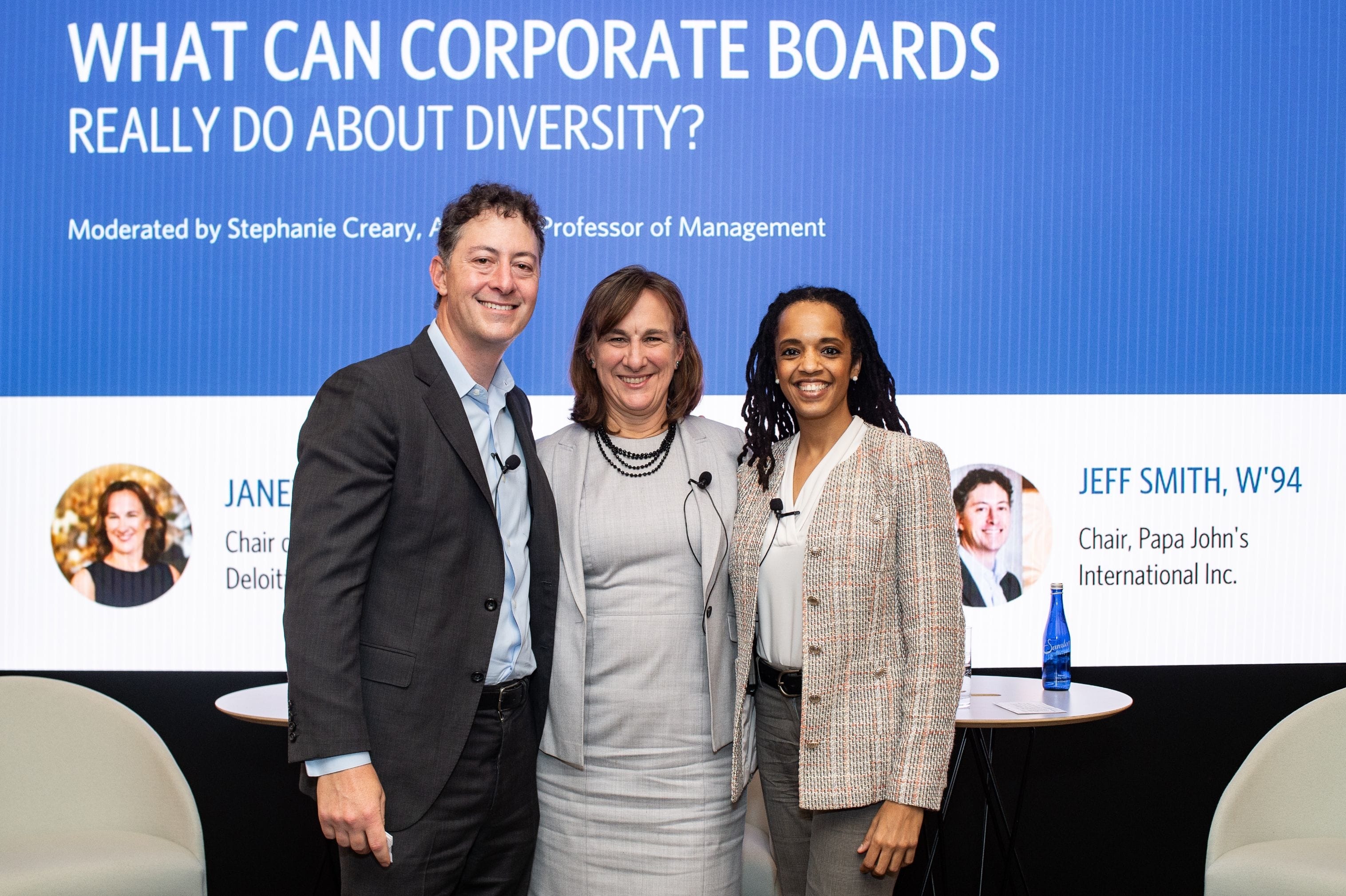It’s clear that diversity and inclusion within a company lead to better business performance. What’s less obvious are the ways companies across the nation can embrace and act on those values. To that end, management professor Stephanie Creary discussed the makeup of boardrooms with two seasoned executives during an on-campus event on Monday, November 11, presented by Leading Diversity@Wharton.
As managing member, CEO, and CIO at activist investor Starboard Value, Jeff Smith W94 plays a crucial role in shaping the boards of publicly traded companies in which the firm invests. He currently serves as board chair for Advance Auto Parts and Papa John’s, businesses in Starboard’s portfolio. Janet Foutty chairs the board at Deloitte, and her experience as the former CEO of the company’s consulting arm has made her an expert on inclusion advocacy in the workplace.
Over the course of the event, Smith and Foutty touched on issues including the importance of having diverse boards, government mandates, and challenges executives need to overcome to ensure talk translates into action.

Smith, Foutty, and Creary talk diversity
A Board’s Responsibility
Foutty calls the board the “conscience of the organization” because of its responsibility to oversee the most essential processes in every organization: management, strategy, and leadership succession. Inclusion needs to be part of those conversations as well, she said. “Having a diverse set of voices around the proverbial table and having an inclusive discussion around the table creates a very different lens into organizational performance.”
Based on his experience advising multiple corporate boards through Starboard, Smith said a good board will represent the interests of shareholders, an action he defined as maximizing value by implementing socially conscious policies. This definition includes diversifying the workforce from the top corporate levels, the benefits of which go beyond inclusion and respect. “This isn’t just a societal good,” he said. “It is supposed to circularly come back around to make the company better. We should all collectively be smarter than any one person. If you have more viewpoints, we should all be smarter. But it is also so we can relate to the workforce, so we can relate to our customer base.”
The Effectiveness of Government Action
Last year, California passed a bill requiring public companies whose principal offices are located in the Golden State to have at least one female director on their boards by the end of 2019. Under the law, that number will increase in subsequent years. Similarly, Illinois enacted a bill in August requiring public companies to present annual board diversity reports to the secretary of state. During the discussion, Foutty and Smith weighed in on the usefulness of efforts like these and whether the government should intervene when it comes to corporate diversity.

A packed house at Huntsman Hall for the Leading Diversity@Wharton event
Foutty says she’s changed her thoughts on these points in recent years. Previously, she was an advocate for an organic movement stirred by a new social momentum. Today, with more executive experience, she contends momentum wasn’t strong enough and change was too slow. “Legislation in and around diversity is a very blunt instrument,” she said, because it diversifies some of the most powerful companies in the country, namely those in Silicon Valley
Taking the opposite viewpoint, Smith said the government is merely riding an already existing wave, adding little to the effort and potentially reaping the benefits. “It took too long, but it is happening now” he said. “I don’t know that increased legislation is necessary. I think that if it is extra disclosure it’s fine, but I think that is happening anyway.” The markets, he said, are doing a better job at policing firms, customers now care enough to demand diversity and disclosure, and workers want to be in diverse environments. He added that companies have realized they need to diversify to attract millennials and members of Generation Z.
Upping Their Game
Regardless of their diverging views on government intervention, Foutty and Smith agreed on steps boards can take to make strides in diversity. Foutty recognized that government action may carry tokenism—the idea that individuals are selected for their diversity rather than for their skills. Legislation also is usually limited to gender diversity, often excluding racial and ethnic considerations, she said.
Even when boards construct diverse member bodies, they may uncover a “recycling” problem: Often, said Foutty, the same people who diversify one board also diversify another. Smith attributes this to boards seeking people with board experience and “boardroom presence” to fill their ranks, leading to a relatively small candidate pool.
How can leaders solve this issue? “Boards just need to do a better job at this,” Smith said. “How do you change it? You put more energy behind it, you put more effort behind it, and you push for diversity of thought. It’s like everything else—you just have to decide it is a priority.”


























